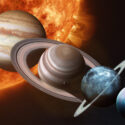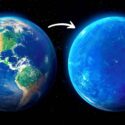This not-so-little piece of equipment could change astronomy forever. And it could be about to find alien life. Maybe in a matter of days. What is this powerful new tool? How could it detect life in galaxies far away? If it does find life, what would happen next?
The James Webb Space Telescope launched into space on December 25th, 2021. Its mission? To study the history of our Universe from the afterglow of the Big Bang to the formation of solar systems like our own. This large infrared telescope is 100 times more powerful than the Hubble telescope. It has 18 separate mirror segments made of ultra-lightweight beryllium.
These unfold and adjust to form a 6.5 m (21 ft) primary mirror. Now that the Webb telescope has reached its destination 1.5 million km (930,000 mi) away from the Earth, it should be able to see into the past of our Universe. It could be the key to discovering alien life. Unless they find us first.
If you were looking for signs of life on distant exoplanets, you wouldn’t look for little green aliens. You’d look for biosignatures. In other words, characteristics in a planet’s atmosphere that could be evidence of life in the past or present. Imagine an alien astronomer from a distant galaxy pointing a telescope toward the Earth.
The biosignatures they’d make note of are the presence of oxygen and methane in our atmosphere. Without lifeforms breathing these two gases in and out, these elements would react with others and disappear. So the James Webb telescope will look for the presence of oxygen and methane too.
First, you’d need to detect the presence of an exoplanet around a distant star. You could do this through the transit method. As a planet passes in front of a star, you’d observe its light slightly diminishing. After that planet passes in front of its star many times, you’d have enough data to take measurements of its atmosphere.
You’d be able to see how much light goes through its atmosphere. And you could determine what atmospheric elements exist there based on the way the light disperses. With a telescope as powerful as the Webb, you could gather enough data after a planet has passed its star as few as five to ten times.
So after only 20 hours of investigating a planet, you could detect conditions for life. But then what? Well, you wouldn’t go public with this information right away. You’d probably want to follow the confidence of life detection scale, commonly referred to as CoLD. This is an approach that scientists at NASA are looking to establish.
It would set up a new framework for discussing how close we are to finding life beyond our planet. The scale would have seven levels. Level one would be the detection of biosignatures. As more data is collected, you’d climb the scale to level seven. At this point, you’d likely find alien life. That’s when the whole world freaks out, and powerful aliens beam down to conquer our planet, right?
Not exactly. If we discover life using the Webb telescope, it would be more likely that WE are the powerful, intelligent beings. The bombshell announcement of alien life would be less dramatic than movies suggest. It could take decades. Be prepared for a slow progression of countless mini announcements.
And remember that the distances between the Earth and exoplanets of interest are vast. If you decided to take on an interstellar trip to one of those, like the exoplanet TRAPPIST-1e, it would take you decades. But scientists believe that this planet may have atmospheric conditions similar to ours. Or at least similar to the Earth two and a half to four billion years ago.
So maybe we could find microscopic life there. A discovery like this would elicit many different reactions. For you, it could be a dream come true. For others, it could be concerning. It could affect your entire understanding of life in the Universe. Surely there will be plenty of ramifications to a discovery so huge.
Sources
- “Why Infrared? (Earliest Galaxies Edition)”. Maggie Masetti. 2013. asd.gsfc.nasa.gov.
- “The James Webb Space Telescope Is Fully Deployed. So What’s Next For The Biggest Observatory Off Earth?”. Elizabeth Howell. 2022. space.com.
- “NASA’s James Webb Telescope Could Detect Alien Life In Just 20 Hours”. Brad Bergan. 2021. interestingengineering.com.
- “NASA Is Thinking Of New Ways To Find Aliens… If They Exist”. Elizabeth Rayne. 2021. syfy.com.
- “A Call For A Methodical Approach To Identifying Life Beyond Earth”. Bob Yirka. 2021. phys.org.



























